lights CHEVROLET BLAZER 1994 2.G Owners Manual
[x] Cancel search | Manufacturer: CHEVROLET, Model Year: 1994, Model line: BLAZER, Model: CHEVROLET BLAZER 1994 2.GPages: 348, PDF Size: 17.88 MB
Page 10 of 348
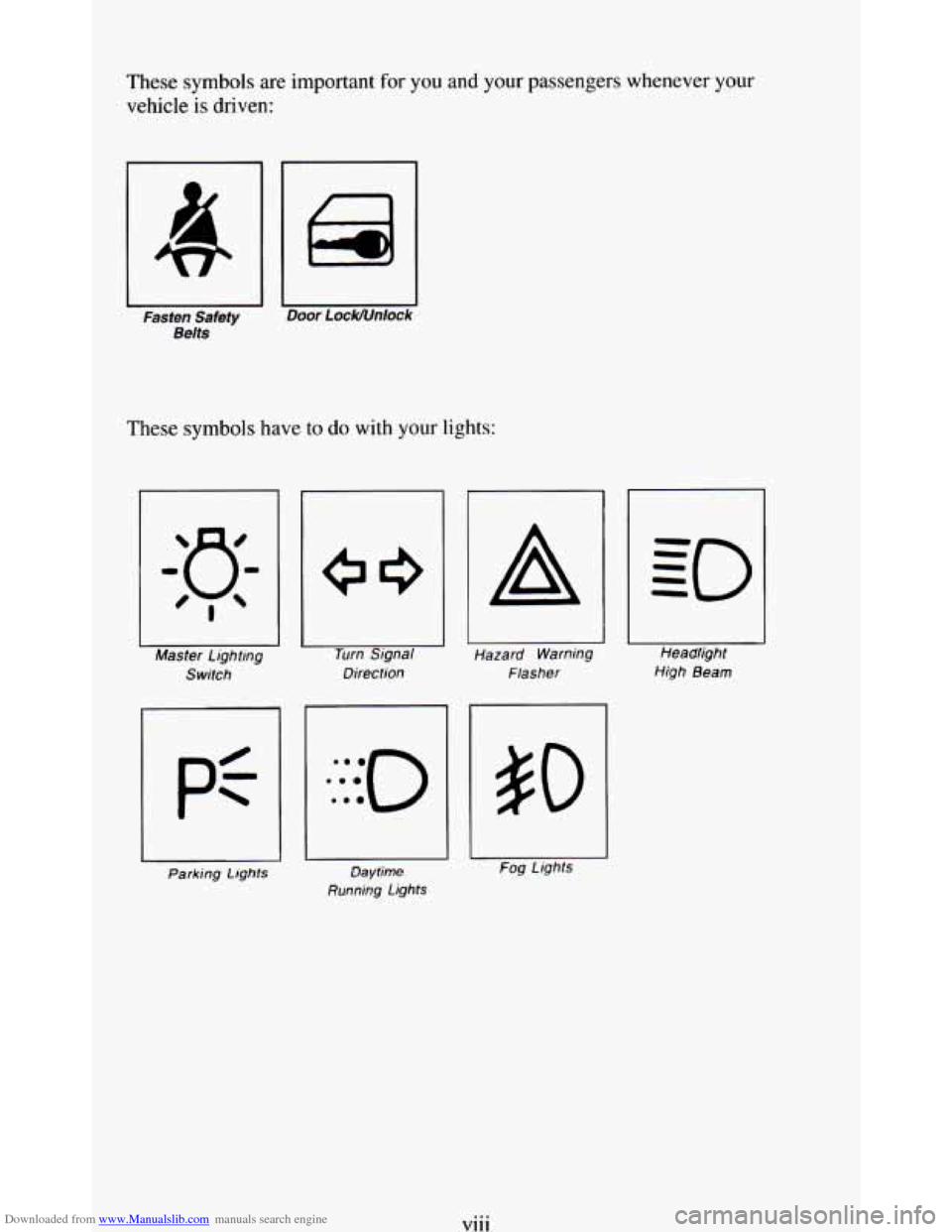
Downloaded from www.Manualslib.com manuals search engine These symbols are important for you and your passengers whenever your
vehicle
is driven:
1 I
Fasfen Safety Door LocWUnlock
Belts
These symbols have to do with your lights:
Master Lighting Turn Signal
Switch Direction
pf
Parking Lights Daytime
Running Lights
A
Hazard Warning
Flasher Headlight
High Beam
$0
fog Lights
v111 . ..
Page 11 of 348
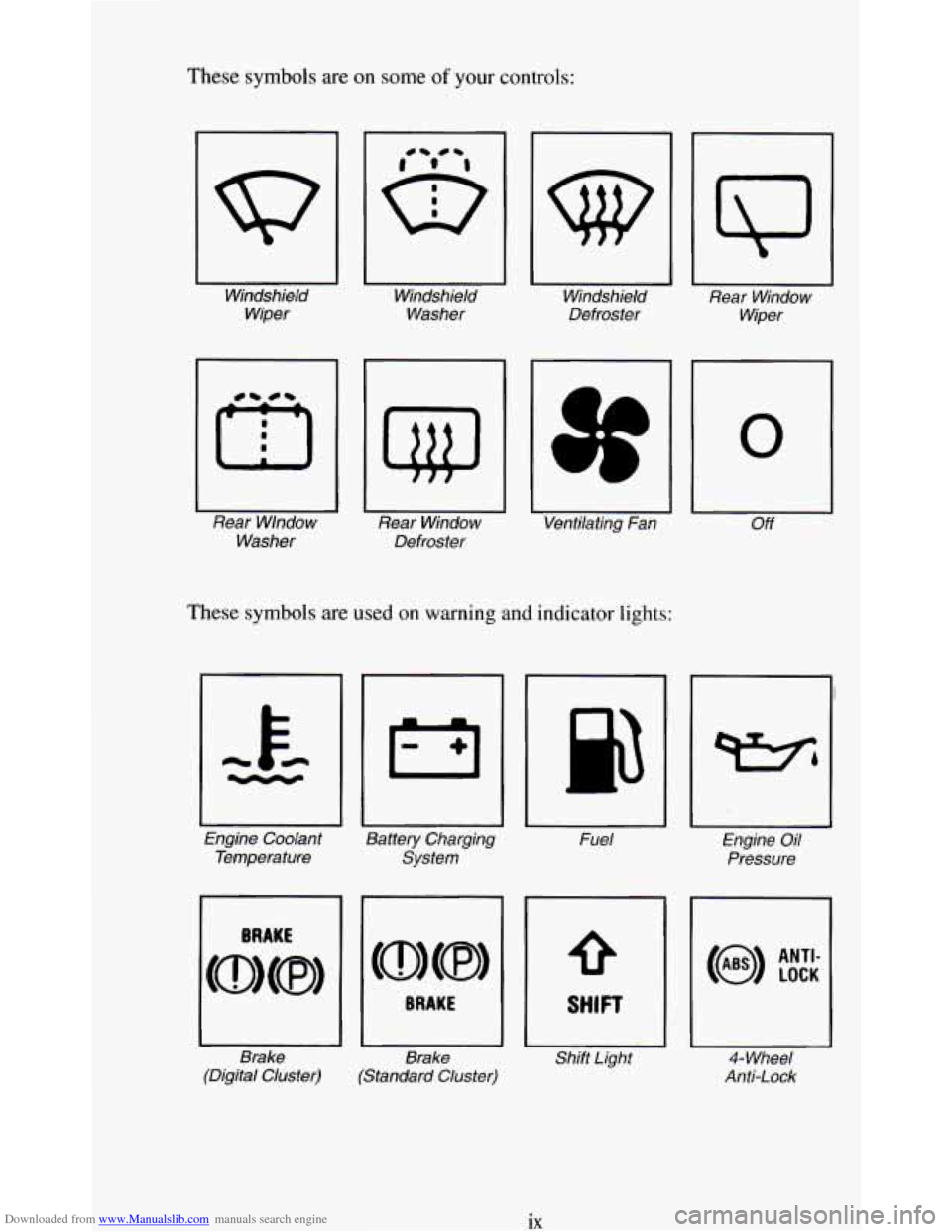
Downloaded from www.Manualslib.com manuals search engine These symbols are on some of your controls:
Windshield Windshield Windshield
Rear Window
Wiper Washer
Defroster
Wiper
Rear Wlndow Rear Window Ventilating Fan
Off
Washer Defroster
These symbols are usea on warning and indicator lights:
0
Engine Coolant
Battery Charging Fuel Engine Oil
Temperature System Pressure
Brake Brake Shift Light
4- Wheel
(Digital Cluster) (Standard Cluster) Anti-Lock
ix
Page 21 of 348
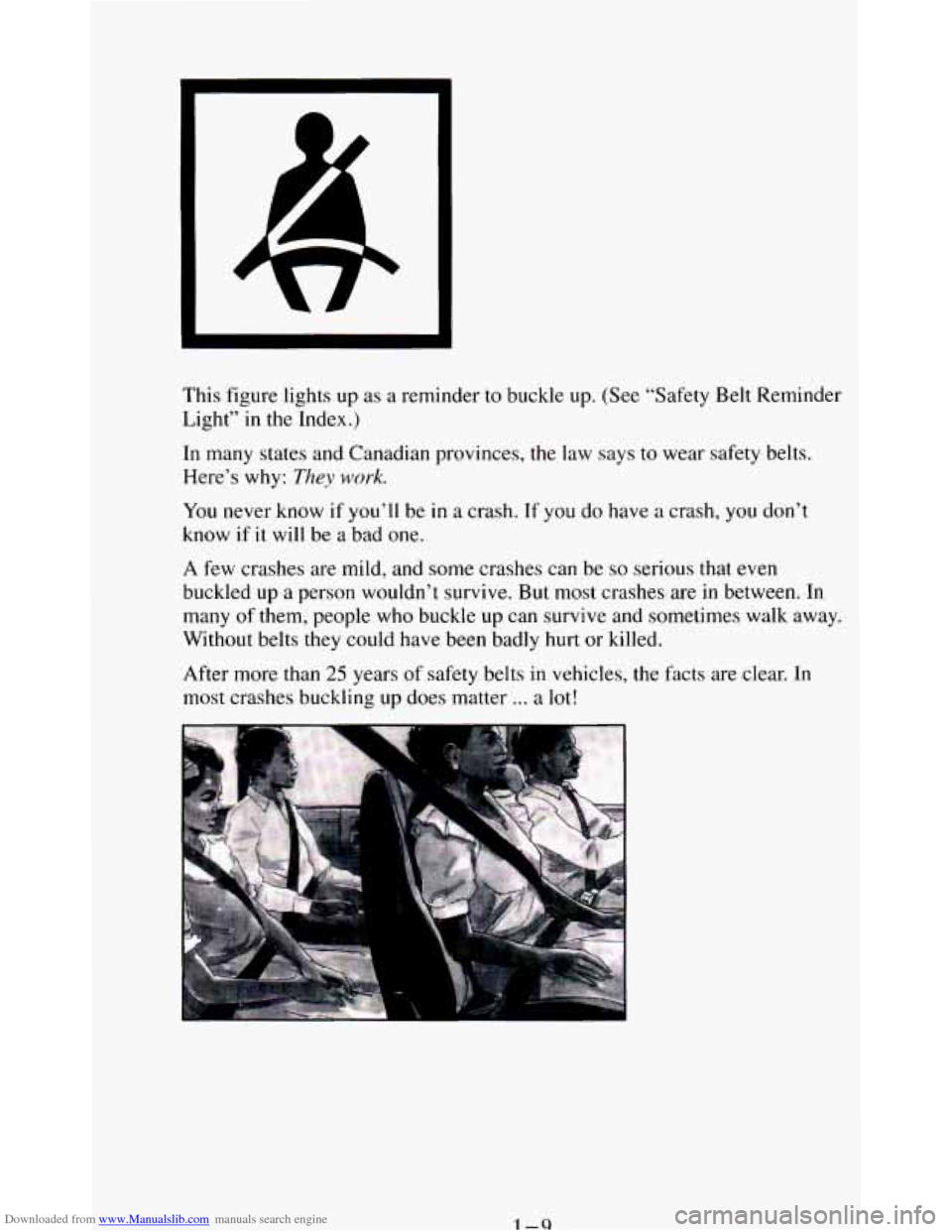
Downloaded from www.Manualslib.com manuals search engine This figure lights up as a reminder to buckle up. (See “Safety Belt Reminder
Light”
in the Index.)
In many states and Canadian provinces,
the law says to wear safety belts.
Here’s why:
They work.
You never know if you’ll be in a crash. If you do have a crash, you don’t
know
if it will be a bad one.
A few crashes are mild, and some crashes can be so serious that even
buckled up a person wouldn’t survive. But
most crashes are in between. In
many
of them, people who buckle up can survive and sometimes walk away.
Without belts they could have been badly hurt or killed.
After more than
25 years of safety belts in vehicles, the facts are clear. In
most crashes buckling up does matter
... a lot!
1 -Q
Page 56 of 348
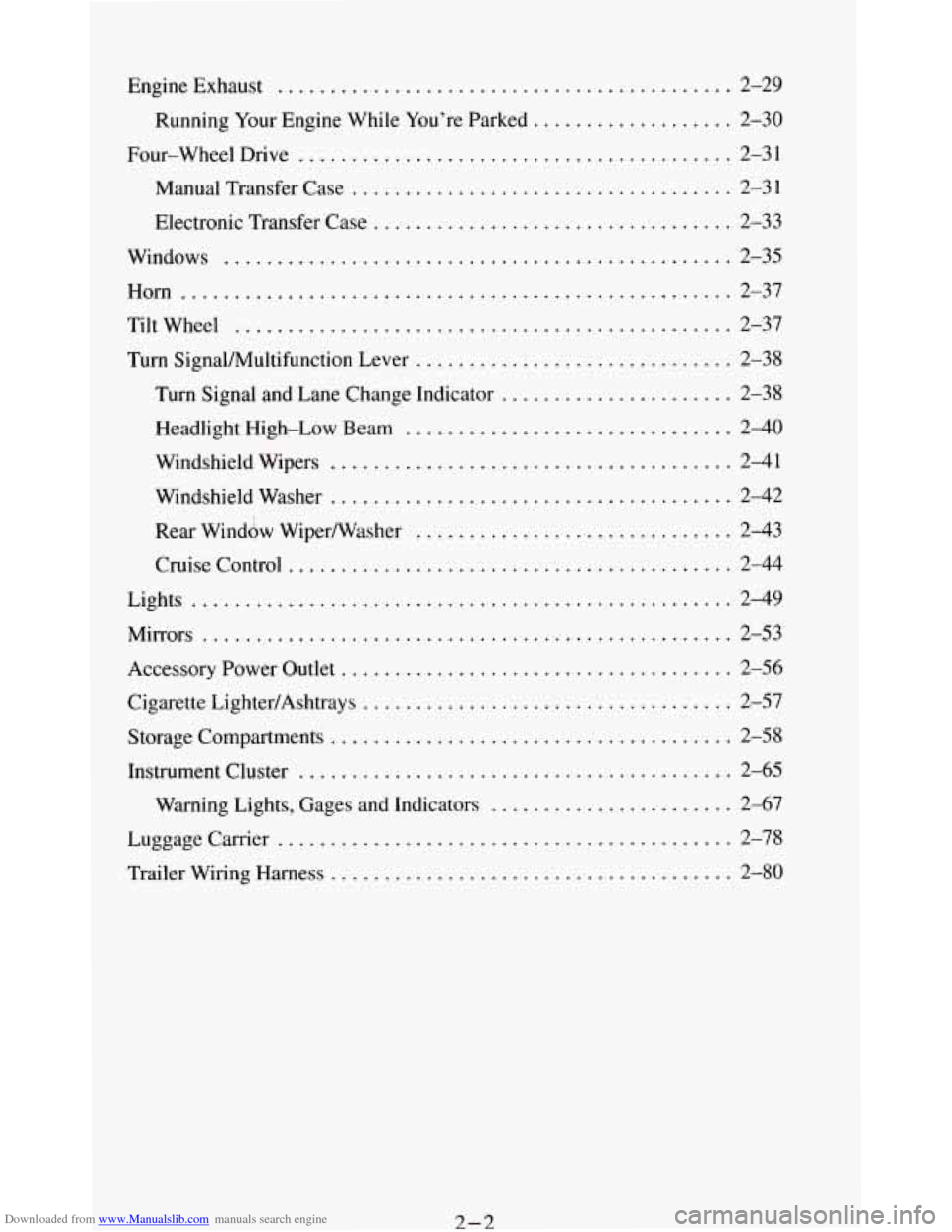
Downloaded from www.Manualslib.com manuals search engine EngineExhaust ........................................... 2-29
Running Your Engine While You’re Parked
................... 2-30
Four-WheelDrive
......................................... 2-31
Manual Transfer Case
.................................... 2-31
Electronic Transfer Case
.................................. 2-33
Windows
................................................ 2-35
Horn
.................................................... 2-37
Tiltwheel
............................................... 2-37
Turn Signal/Multifunction Lever
.............................. 2-38
Turn Signal and Lane Change Indicator
...................... 2-38
Headlight High-Low Beam
............................... 2-40
Windshield Wipers
...................................... 2-41
Windshield Washer
...................................... 2-42
Rear Window Wiper/Washer
.............................. 2-43
Cruise Control
.......................................... 2-44
Lights
................................................. 2-49
Mirrors
.................................................. 2-53
Accessory Power Outlet
..................................... 2-56
Cigarette LightedAshtrays
................................... 2-57
Storage Compartments
...................................... 2-58
Instrument Cluster ......................................... 2-65
Warning Lights. Gages
and Indicators ....................... 2-67
Luggagecarrier
........................................... 2-78
Trailer Wiring Harness
...................................... 2-80
2-2
Page 86 of 348
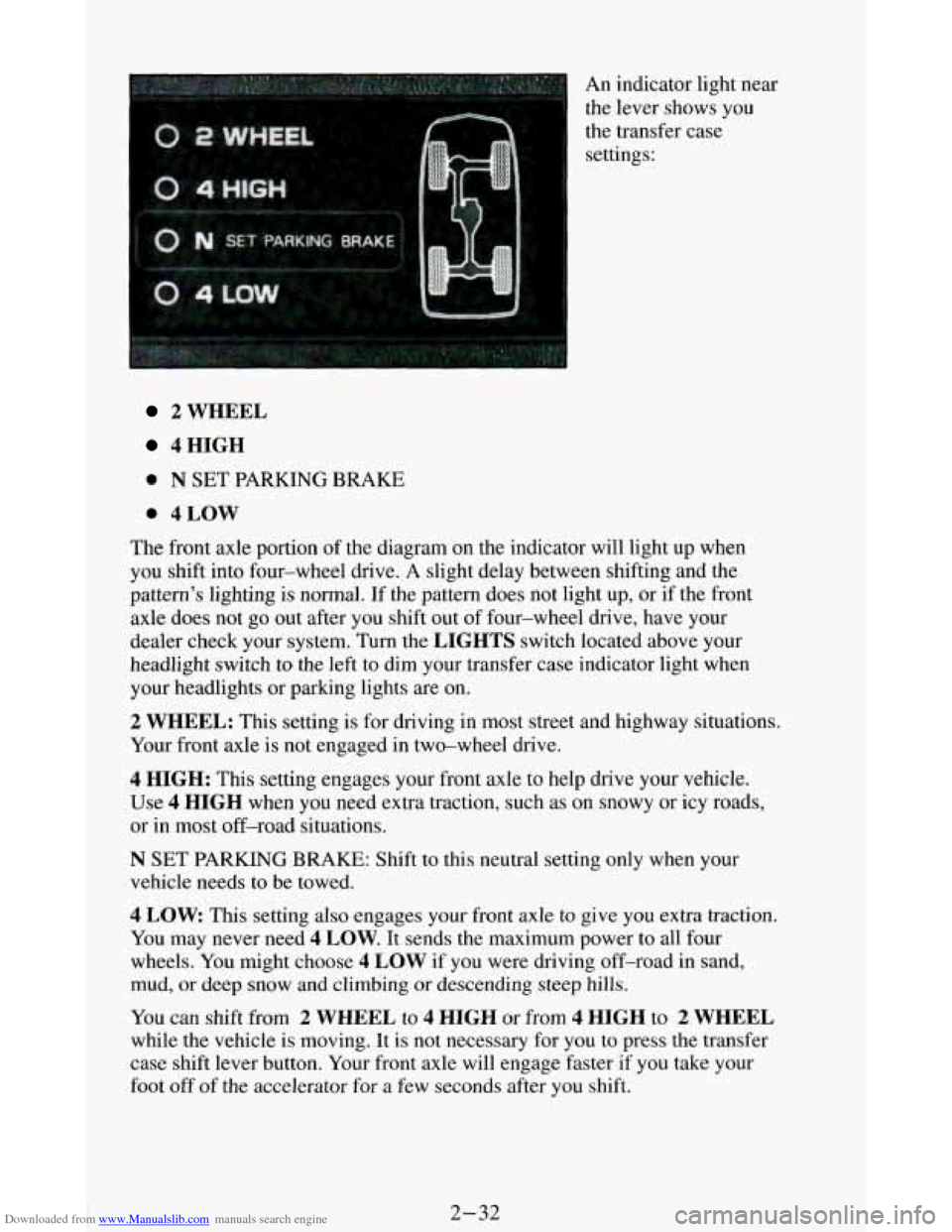
Downloaded from www.Manualslib.com manuals search engine An indicator light near
the lever shows you
the transfer case
settings:
2 WHEEL
4HIGH
0 N SET PARKING BRAKE
0 4LOW
The front axle portion of the diagram on the indicator will light up when
you shift into four-wheel drive.
A slight delay between shifting and the
pattern's lighting
is normal. If the pattern does not light up, or if the front
axle does not go out after you shift out of four-wheel drive, have your
dealer check your system. Turn the
LIGHTS switch located above your
headlight switch
to the left to dim your transfer case indicator light when
your headlights or parking lights are on.
2 WHEEL: This setting is for driving in most street and highway situations.
Your front axle
is not engaged in two-wheel drive.
4 HIGH: This setting engages your front axle to help drive your vehicle.
Use 4 HIGH when you need extra traction, such as on snowy or icy roads,
or
in most off-road situations.
N SET PARKING BRAKE: Shift to this neutral setting only when your
vehicle needs to be towed.
4 LOW This setting also engages your front axle to give you extra traction.
You may never need
4 LOW. It sends the maximum power to all four
wheels. You might choose
4 LOW if you were driving off-road in sand,
mud, or deep snow and climbing or descending steep hills.
You can shift from 2 WHEEL to 4 HIGH or from 4 HIGH to 2 WHEEL
while the vehicle is moving. It is not necessary for you to press the transfer
case shift lever button. Your front axle will engage faster if you take your
foot off of the accelerator for a few seconds after you shift.
2-32
Page 88 of 348
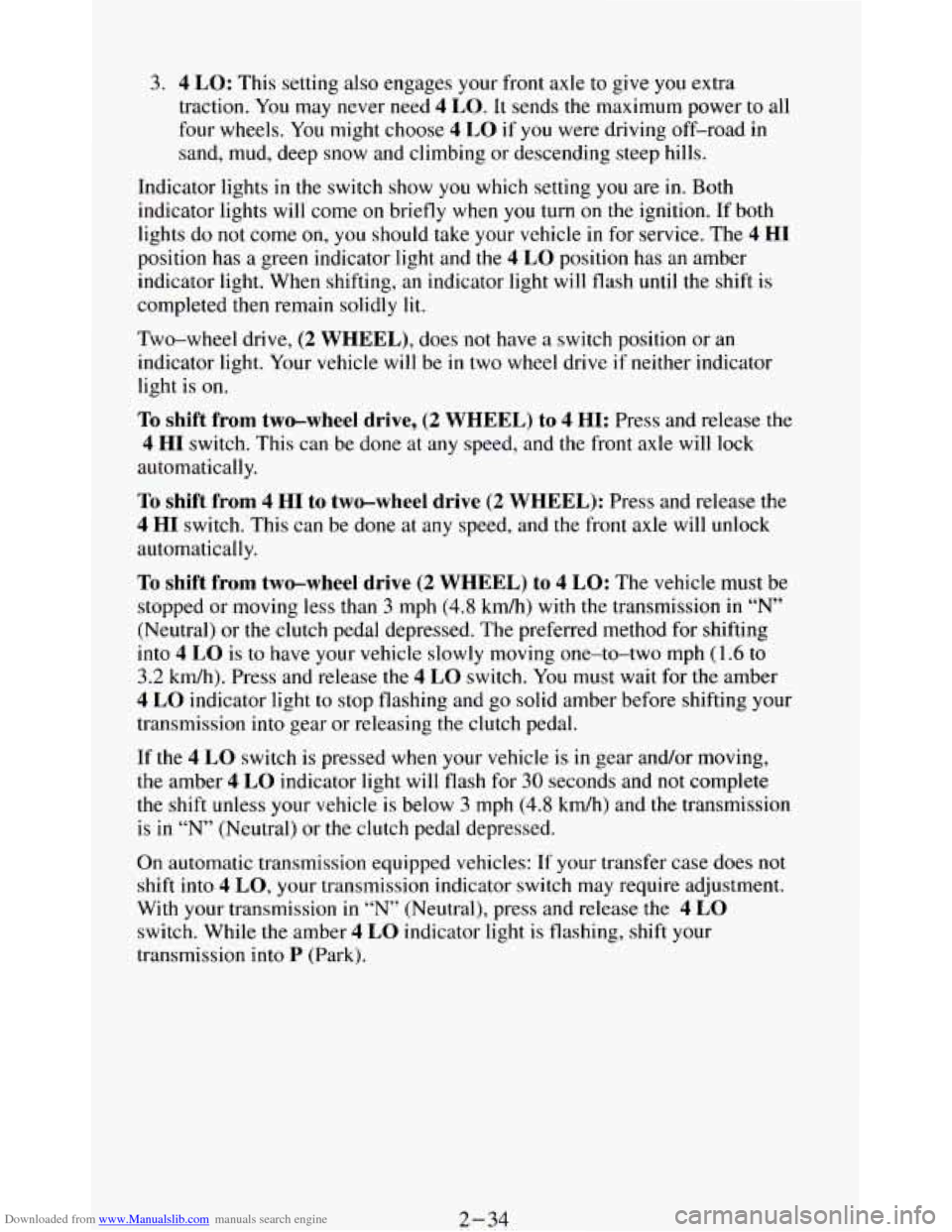
Downloaded from www.Manualslib.com manuals search engine 3. 4 LO: This setting also engages your front axle to give you extra
traction. You may never need
4 LO. It sends the maximum power to all
four wheels.
You might choose 4 LO if you were driving off-road in
sand, mud, deep snow and climbing or descending steep hills.
Indicator lights
in the switch show you which setting you are in. Both
indicator lights will come on briefly when
you turn on the ignition. If both
lights do
not come on, you should take your vehicle in for service. The 4 HI
position has a green indicator light and the 4 LO position has an amber
indicator light. When shifting, an indicator light will flash
until the shift is
completed then remain solidly lit.
Two-wheel drive, (2 WHEEL), does not have a switch position or an
indicator light. Your vehicle will be
in two wheel drive if neither indicator
light is
on.
To shift from two-wheel drive, (2 WHEEL) to 4 HI: Press and release the
4 HI switch. This can be done at any speed, and the front axle will lock
automatically.
To shift from 4 HI to two-wheel drive (2 WHEEL): Press and release the
4 HI switch. This can be done at any speed, and the front axle will unlock
automatically.
To shift from two-wheel drive (2 WHEEL) to 4 LO: The vehicle must be
stopped or moving less than
3 mph (4.8 km/h) with the transmission in “N’
(Neutral) or the clutch pedal depressed. The preferred method for shifting
into
4 LO is to have your vehicle slowly moving one-to-two mph (1.6 to
3.2 kdh). Press and release the 4 LO switch. You must wait for the amber
4 LO indicator light to stop flashing and go solid amber before shifting your
transmission
into gear or releasing the clutch pedal.
If the
4 LO switch is pressed when your vehicle is in gear and/or moving,
the amber
4 LO indicator light will flash for 30 seconds and not complete
the shift unless your vehicle is below
3 mph (4.8 kdh) and the transmission
is in
“N” (Neutral) or the clutch pedal depressed.
On automatic transmission equipped vehicles: If your transfer case does not
shift into
4 LO, your transmission indicator switch may require adjustment.
With your transmission in
“N” (Neutral), press and release the 4 LO
switch. While the amber 4 LO indicator light is flashing, shift your
transmission into
P (Park).
2-34
Page 93 of 348
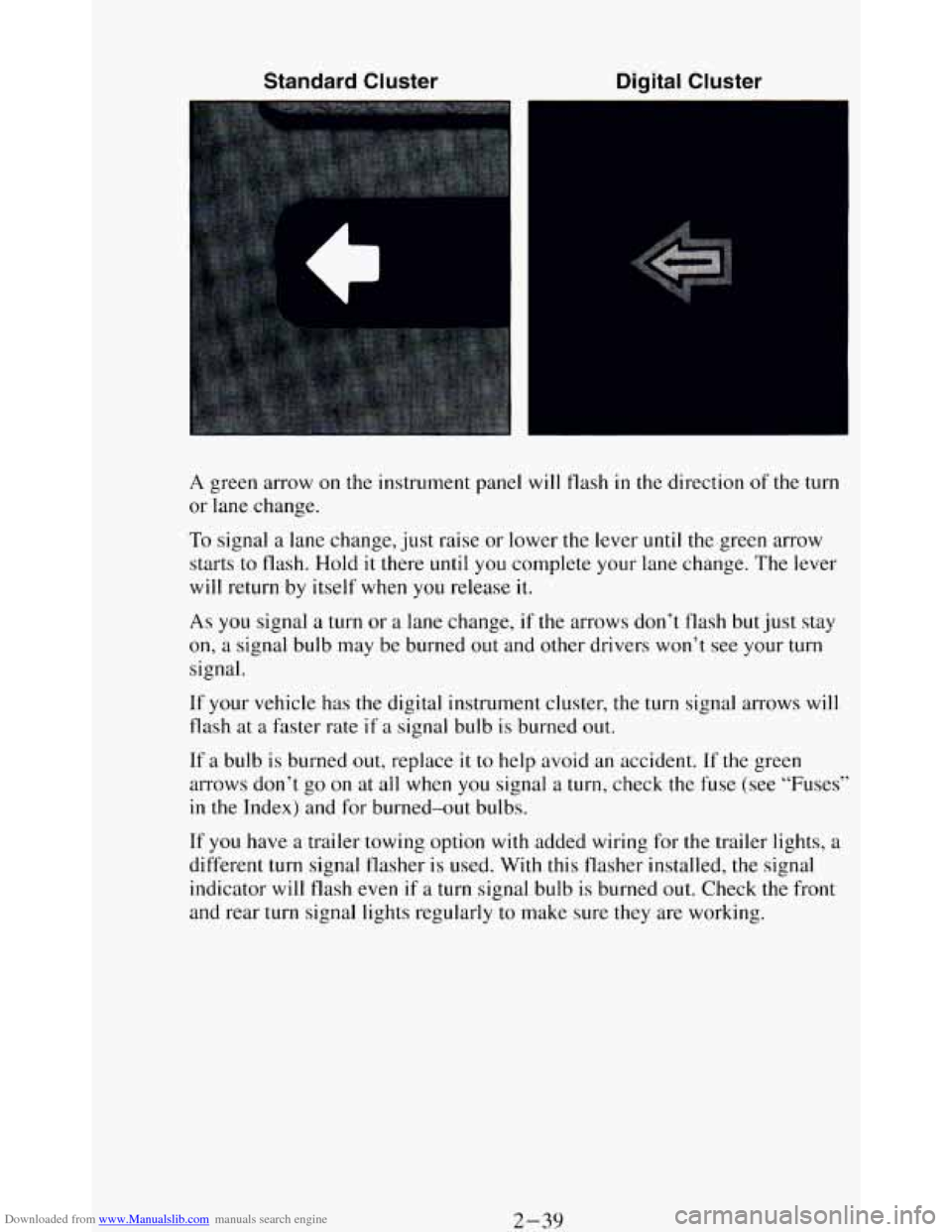
Downloaded from www.Manualslib.com manuals search engine Standard Cluster Digital Cluster
A green arrow on the instrument panel will flash in the direction of the turn
or lane change.
To signal
a lane change, just raise or lower the lever until the green arrow
starts to flash. Hold
it there until you complete your lane change. The lever
will return by itself when you release it.
As you signal a turn or a lane change, if the arrows don’t flash but just stay
on,
a signal bulb may be burned out and other drivers won’t see your turn
signal.
If your vehicle has the digital instrument cluster, the turn signal arrows will
flash at
a faster rate if a signal bulb is burned out.
If a bulb is burned out, replace it to help avoid an accident. If the green
arrows don’t go on at all when you signal a turn, check the fuse (see “Fuses”
in the Index) and for burned-out bulbs.
If
you have a trailer towing option with added wiring for the trailer lights, a
different turn signal flasher is used. With this flasher installed, the signal
indicator will flash even if
a turn signal bulb is burned out. Check the front
and rear turn signal lights regularly to make sure they are working.
2-39
Page 94 of 348
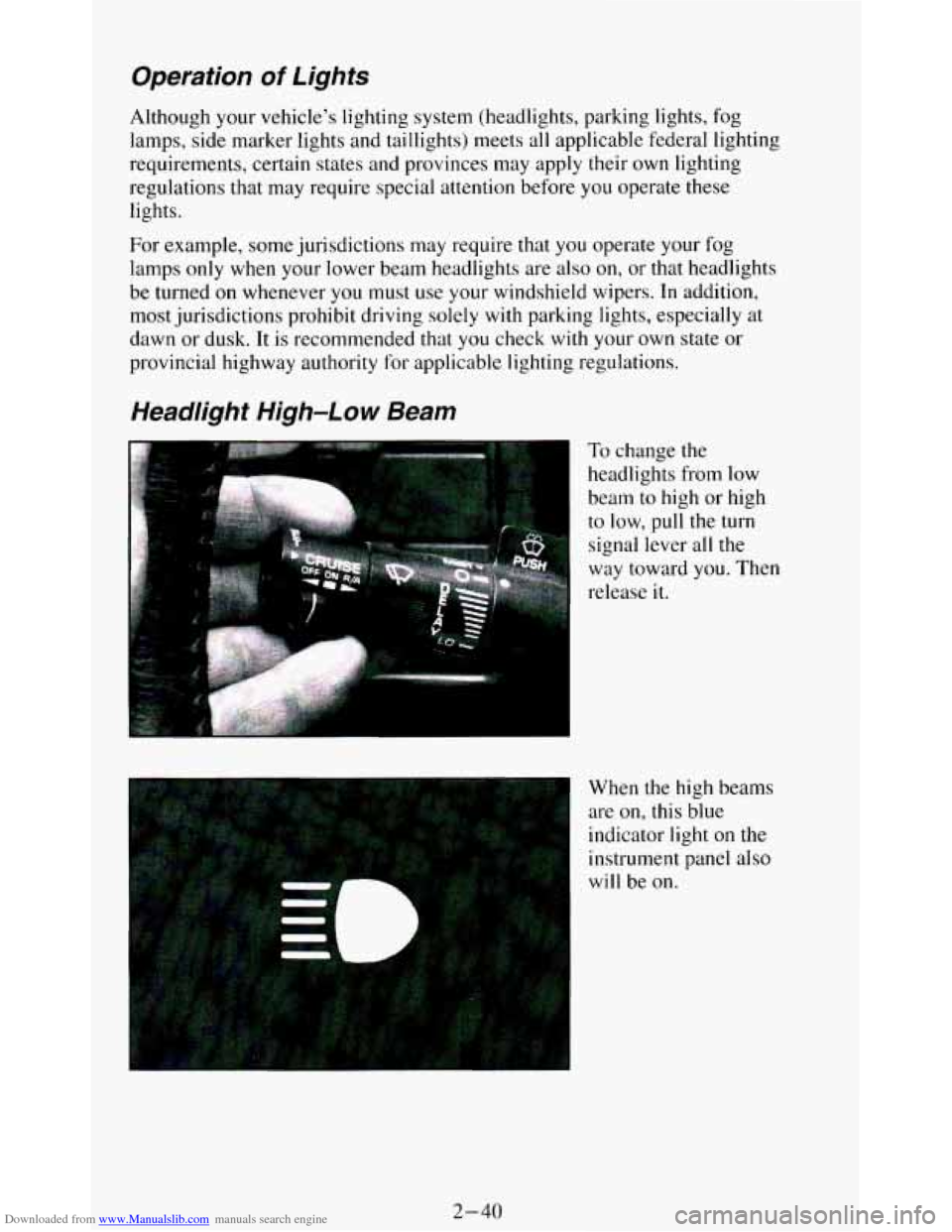
Downloaded from www.Manualslib.com manuals search engine Operation of Lights
Although your vehicle's lighting system (headlights, parking lig\
hts, fog
lamps, side marker lights and taillights) meets
all applicable federal lighting
requirements, certain states and provinces may apply their own lighting
regulations that may require special
attention before you operate these
lights.
For example, some jurisdictions may require that you operate your fog
lamps
only when your lower beam headlights are also on, or that headlights
be turned
on whenever you must use your windshield wipers. In addition,
most jurisdictions prohibit driving solely with parking lights, especially at
dawn or dusk. It is recommended that
you check with your own state or
provincial highway authority for applicable lighting regulations.
Headlight High-Low Beam
To change the
headlights from low
beam to high or high
to
low, pull the turn
signal lever all the
way toward you. Then
release
it.
When the high beams
are
on, this blue
indicator light on the
instrument panel also
will be on.
2-40
Page 103 of 348
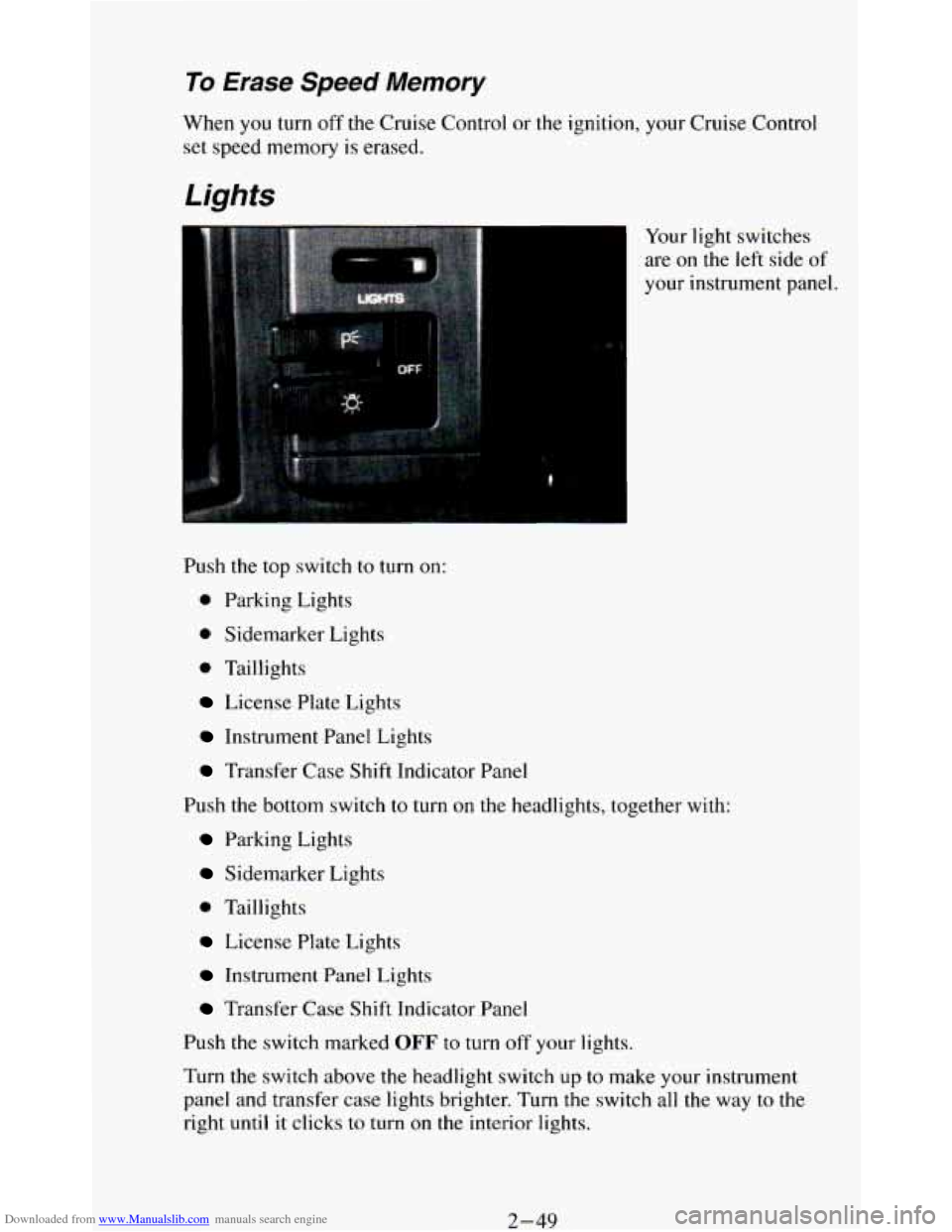
Downloaded from www.Manualslib.com manuals search engine To Erase Speed Memory
When you turn off the Cruise Control or the ignition, your Cruise Control
set speed memory
is erased.
Lights
Your light switches
are on the left side of
your instrument panel.
Push the top switch to turn on:
0 Parking Lights
0 Sidemarker Lights
0 Taillights
License Plate Lights
Instrument Panel Lights
Transfer Case Shift Indicator Panel
Push
the bottom switch to turn on the headlights, together with:
Parking Lights
Sidemarker Lights
0 Taillights
License Plate Lights
Instrument Panel Lights
Transfer Case Shift Indicator Panel
Push the switch marked
OFF to turn off your lights.
Turn the switch above the headlight switch
up to make your instrument
panel and transfer
case lights brighter. Turn the switch all the way to the
right until it clicks to turn on the interior lights.
2-49
Page 104 of 348
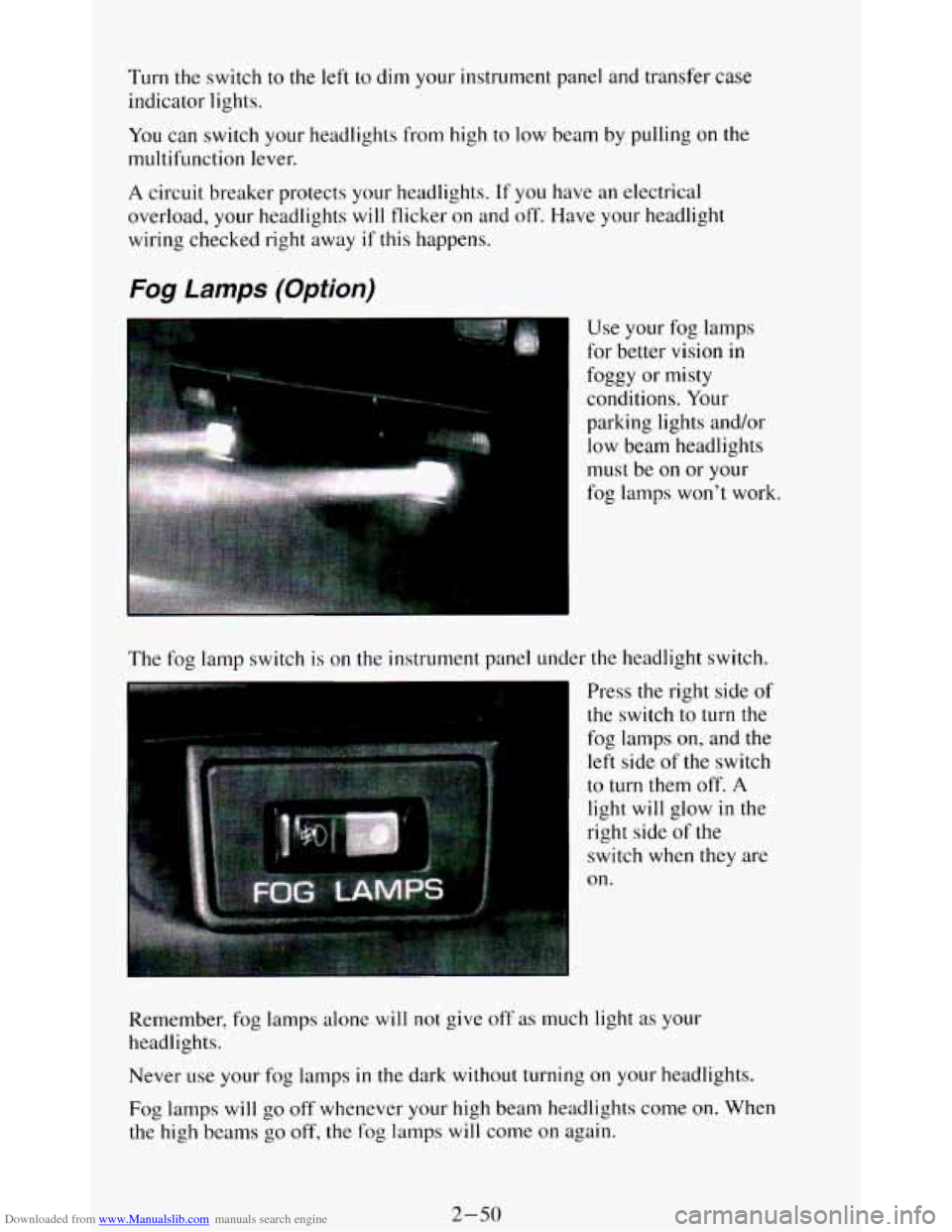
Downloaded from www.Manualslib.com manuals search engine Turn the switch to the left to dim your instrument panel and transfer case
indicator lights.
You can switch your headlights from high to low beam by pulling on the
multifunction lever.
A circuit breaker protects your headlights. If you have an electrical
overload, your headlights will flicker
on and off. Have your headlight
wiring checked right away
if this happens.
Fog Lamps (Option)
The fog lamp switch is on the instrument panel under the headlight switch.
Press the right side of
the switch
to turn the
fog lamps
on, and the
left side of the switch
to turn them off. A
light will glow in the
right side
of the
switch
when they are
on.
Remember, fog lamps alone
will not give off as much light as your
headlights.
Never
use your fog lamps in the dark without turning on your headlights.
Fog lamps will
go off whenever your high beam headlights come on. When
the high beams
go off, the fog lamps will come on again.
2-50